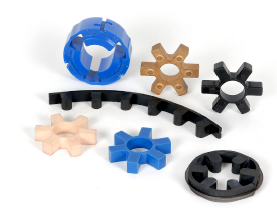Jaw Sort Coupling Assortment Process
The  variety process for determining the correct jaw coupling size and elastomer involves applying the charts proven over the following pages. There are actually three elements for being selected, two hubs and a single elastomer. When the shaft dimension of your driver and driven of your application are with the exact same diameter, the hubs chosen will likely be the same. When shaft diameters vary, hubs picked will differ accordingly.
variety process for determining the correct jaw coupling size and elastomer involves applying the charts proven over the following pages. There are actually three elements for being selected, two hubs and a single elastomer. When the shaft dimension of your driver and driven of your application are with the exact same diameter, the hubs chosen will likely be the same. When shaft diameters vary, hubs picked will differ accordingly.
Facts important before a coupling can be picked:
HP (or KW) and RPM or Torque of driver
Shaft sizes of driver and driven products and corresponding keyways
Application description
Environmental situations (i.e. intense temperature, corrosive disorders, space limitations)
Measures In Picking out A Jaw Coupling
Step one: Decide the Nominal Torque of the application by using the next formula:
Nominal Torque = in-lb = (HP x 63025)/RPM
Nm = (KW x 9550)/RPM
Phase two: Using the Application Support Elements Chart one select the service factor which greatest corresponds for your application.
Step 3: Calculate the Style Torque of the application by multiplying the Nominal Torque calculated in Phase 1 from the Application Support Factor determined in Stage 2.
Design Torque = Nominal Torque x Application Support Component
Phase 4: Working with the Spider Effectiveness Information Chart 2, choose the elastomer materials which finest corresponds to your application.
Phase five: Working with the Jaw Nominal Rated Torque Chart 3 , find the proper elastomer material column for the elastomer picked in Step 4.
Scan down this column to your first entry exactly where the Torque Worth during the acceptable column is better than or equal towards the Design and style Torque calculated in Phase 3.
When this value is found, refer to the corresponding coupling size in the to start with column of your Jaw Nominal Rated Torque Chart 3 .
Refer to the highest RPM value for this elastomer torque capability to make certain the application demands are met. If your requirement is not happy at this time, a different type of coupling can be necessary to the application. Please seek the advice of Lovejoy engineering for help.
Phase six: Assess the application driver/driven shaft sizes towards the maximum bore size accessible around the coupling selected. If coupling bore dimension is not massive enough for that shaft diameter, select the next largest coupling that will accommodate the driver/driven shaft diameters.
Stage 7: Working with the UPC quantity choice table , find the proper Bore and Keyway sizes necessary and locate the quantity.
